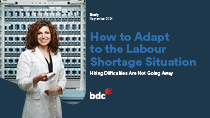Which online payment processor is best for your business?
BDC
Taking your small business online with an e-commerce website can be a great way to find new customers and grow your business. But before you jump in, one of your most important considerations will be how to process online payments.
BDC Director, Revenue Growth and Expansion, Martin Wiedenhoff says there are four main points to keep in mind when considering how to process payments through your e-commerce website.
1. Know your customers
How will your online customers want to make payments? If you already have a bricks-and-mortar store, you may want to offer them the same credit, debit and pre-paid card options that you give to your in-person customers. That said, going online will hopefully bring you a broad range of new customers—some of whom might like to pay in different ways.
" Simply replicating what you have in-store is the easiest move. But you need to consider the potential impact on your sales if your online customers can’t find the payment options they prefer."
Martin Wiedenhoff , BDC Senior Business Advisor
For example, maybe you don’t support a particular credit card in-store because local customers don’t use it—but online buyers might. On the other hand, even though debit is widely used in-store, it may not be the best option for e-commerce because Canadians rarely use it to make large online purchases. Do some market research on where your prospects are located and how they are likely to want to pay. You can start by researching the payment options offered by your competitors.
In the end, Wiedenhoff says most small businesses can get by with just three or four different payment processors for e-commerce.
“It doesn’t make business sense to offer 25 different payment options,” he says. “But you do need to assess the opportunity costs that come with saying ‘no’ to certain ones.”
2. Look at all your options
As with point-of-sale (POS) systems, there are many online payment providers and platforms to choose from, each with pros and cons. Not all solutions are available in all countries—something to think about if you’re selling internationally.
Your bank may offer an online payment solution, such as Moneris, which is likely an extension of the credit and debit system you use in-store. You could potentially qualify for a volume discount if you run both POS and online payments through your existing provider.
Other providers are cloud-based, offering software-as-a-service (SaaS) payment platforms. PayPal and Stripe fall into this category. These can be more expensive than the more established options but often come with extra features, like dispute resolution and fraud protection, that lead to a better overall customer experience. (If you do go the SaaS route, first find out how easily it will integrate with your accounting software.)
3. Understand the fees
As with in-store POS, e-commerce payment system providers charge a percentage fee (usually less than 5%) on each transaction. Every provider has different rates, so be sure to visit their websites for the most up-to-date information. Also, make sure to find out about other potential charges, including monthly fees, minimum volume fees, chargeback fees and currency conversion fees—all of which can quickly add up. If a certain provider is more expensive, what are you getting for that extra cost?
4. Keep it secure
You cannot handle online payments without good IT security. What would happen to your customers—and your reputation—if somebody were to hack into your account and steal personal or financial information? You need to make sure your e-commerce site can encrypt and secure the data being provided by your customers.
Adding it all up
As you’re determining the best online payment system to offer to your customers, Wiedenhoff recommends carefully calculating your profit margin for every line item of an online transaction.
If you add up all the costs—not just the transaction fees related to your payment system but also shipping, returns and other expenses—and you still come out with a profit, you’re in good shape. If not, there may be certain products you’ll want to sell in-store only.
“It’s easy to think you’ll sell more products to more people just by having an e-commerce site,” says Wiedenhoff. “But by doing your research and looking at all the costs involved, you’ll have a much more accurate picture of the true opportunity.”
That may mean a bit more work for you in the beginning—but by taking the time to do the math, you’ll be able to make better decisions about your online payment system and your overall e-commerce strategy.
Read the original article here
Check out their profile on CollabHub here


